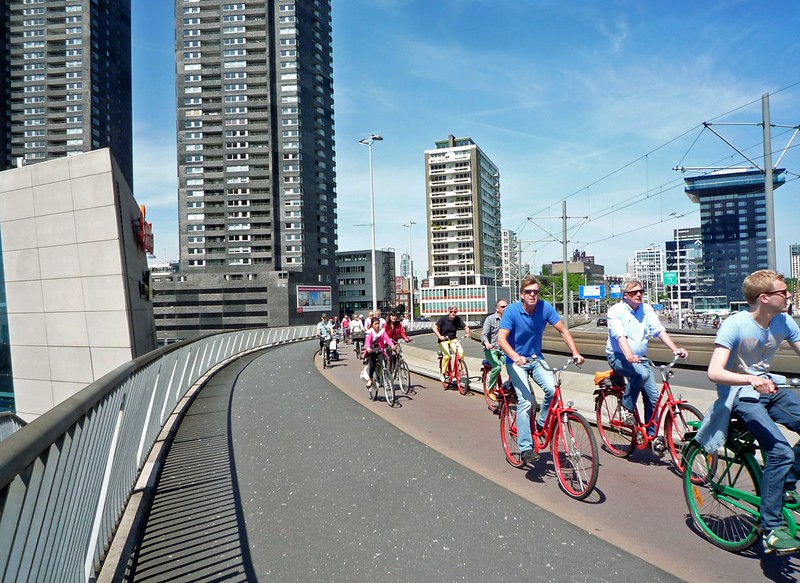The average citizen in the US and the EU spends more than 200 hours a year commuting, and that comes with a lot of emissions. The US’ transportation sector replaced electric power generation as the top source of pollution in 2017. And in 2018, passenger vehicles composed 45.1% of transport emissions in the US. The “15-minute city” model aims to promote accessibility to essential urban services, making them less than a 15-minute walk away. This would make cities more sustainable and convenient, improving the mobility and wellbeing of residents.
—
The COVID-19 pandemic challenged our fundamental understanding of city life. People used to commute to an urban core for work, but as commuting was suspended due to COVID-19-related lockdowns in 2020, global CO2 emissions decreased by 17% compared to 2019 levels. With clear social, economic and environmental benefits, it is in a city’s best interest to increase mobility and reduce commuting distances. City planners have the responsibility to develop regional communities, in particular, providing better infrastructure and mobility solutions for residents.
The “15-minute city” model centres around the concepts of mobility and convenience. It was developed by Carlos Moreno in 2016, a French-Colombian professor studying technology and cities. He observed that 66% of public space in Paris is dedicated to cars, but “individual cars only move 17% of the population.” The model would bring social, economic and cultural opportunities less than 15 minutes away from residents.
You might also like: Hong Kong Announces Waste Management Plan
With everything being so readily accessible, residents would rely less on car rides and public transport, reducing urban heat, carbon emissions and redundant travelling time. To reach such a goal, municipal governments will have to bring shops, schools, employment and entertainment to the suburbs, incentivising residents to travel on foot or bike instead of by car.
Based at the Sorbonne in Paris, Professor Moreno also proposed that telepresence and digital technology will offer collaborative services for a new generation of employees, taking advantage of shared public spaces and further reducing business travel.
Focusing on Sustainable Local Development
The 15-minute city model gained recognition among academics and planners around the world, especially during the pandemic, for the potential it held for future urban areas.
For one, decentivising car ownership and promoting greener ways of transport could reduce carbon emissions significantly – predictions show that if just 100 people switch to biking, it would reduce 460 metric tonnes of carbon emissions per year.
The 15-minute city model was a core part of Paris mayor Anne Hidalgo’s re-election campaign in 2014. With walkability and greening in mind, Hidalgo sought “hyper proximity,” aiming to stitch car-centric neighbourhoods together with cycleways. The historical city has a dense urban core – implementing these projects would facilitate better trade and health within citizens. Anne Hidalgo continues to work with the 15-minute city model, with plans to emerge out of COVID-19 with a total of 650 kilometres of bike lanes.
Other governments have also identified problems in infinitely sprawling communities, lacking adequate urban opportunities and only accessible by private cars. Hence they have adapted the model for development projects in their own cities.
In Australia, nearly 90% of residents live in metropolitan areas – and in the suburbs, high car ownership demonstrates the lack of adequate public transport, which can cause large amounts of financial burden. Professor Graham Currie from Monash University comments “there’s no choice for them but to have a car.”
As a solution, the City of Melbourne has been using a “20-minute neighbourhood” model to develop walkable communities for living, working and playing. The plan is to invest in mixed-use public spaces and quality public transport. Successful implementation could reduce daily greenhouse gas emissions by more than 370,000 tonnes, creating significant positive externalities in the metropolitan area. In particular, urban greening and water management were included in the plans for cooler streetscapes. Melbourne’s 20-minute city plan should help reach its net zero emissions goal in 2050. Similarly, Portland, in the US state of Oregon, will also use the 20-minute model as a central climate action.
Sweden took the 15-minute city model even further, focusing on the development of streets and intersections. Led by innovation agency Vinnova, the “1-minute city” ensures that basic amenities and public spaces are on every street. Their bottom-up approach to urban design aims to connect residents directly to their built environment. Nine Swedish cities are aiming to reach net zero emissions by 2030 – this aggressive 1-minute city model should help achieve this goal, converting citizens to a new era of green living.
Barcelona experimented with its own urban development scheme, introducing “superblocks” back in 2016. While the 15-minute model measures accessibility by travel time, the “superblocks” concept defines it by travel distance. Clusters of 9 city blocks are a “superblock,” restricting traffic to its perimeter. Calculations on 21 superblocks across Eixample and other areas will increase pedestrian space by 33.4 hectares. Despite resistance from motorists, noise pollution and nitrogen oxide emissions in these areas instantly decreased, with small businesses thriving around pedestrian areas. It is clear that urban redevelopment and walkability schemes are a win-win for both communities and their people.
Creating More Inclusive Environments
Apart from environmental and economical benefits, the 15-minute model also solves some fundamental social issues surrounding city life. When governments concentrate on developing residential and suburban neighbourhoods, benefits arise for residents in all racial and economic groups.
The lowest income households in suburban communities will feel the most financial pressure to own a car. With more investment in walkability schemes and public transport infrastructure, low-income families will no longer have to worry about maintaining a car, allowing them to remain in the city. Predictions show that a family in New York could save USD$14 501 yearly just from switching to public transit, taking away the financial burden and restoring some economic freedom for said families.
Furthermore, the model’s emphasis in improving walkability is supported by a business case. UK walking charity Living Streets found a 30% increase in footfall after a £10 million investment in Stoke-on-Trent, suggesting that walkability schemes give competitive financial returns when compared to other transportation schemes. With widened pavements and safer public squares, pedestrians will enjoy more street performances and small businesses like cafes and bookstores. Meanwhile such schemes create positive externalities for residents in the area, who will find better employment opportunities.
The 15-minute model could also mitigate racial disparity in many American cities. A geographical study from the New York Times’ climate team found a correlation between formally redlined areas and higher urban heat. This is because formally redlined areas tend to be paved with concrete, with less greenery, trapping heat amongst the buildings.
In Richmond, Virginia, the neighbourhood Gilpin is 3 to 10 Celsius hotter than wealthier parts of the city. Like many car-centric neighbourhoods, Gilpin would benefit majorly from increased greening programmes and more public investment to cool the area. Under the 15-minute model, Gilpin residents would also get better public transport, connecting them to daily activities downtown.
The 15-minute model encourages better green space, with trees acting as canopies in public spaces, solving issues with heat. Reducing car traffic will also lessen air pollution and improve the quality of life for residents in formally redlined neighbourhoods.
Applying the Model in Other Places
The 15-minute city model isn’t about advocacy or radical change. It is not a movement or a petition. It exists simply to improve the sustainability and accessibility of neighbourhoods around us, even helping create equitable communities for lower income residents.
Any city of any geographical layout can reap the benefits of the model, because it simply requires rethinking our environment, to consider the centre of urban life not as cars, but as the people who fill it with life.
Featured image by: Flickr













